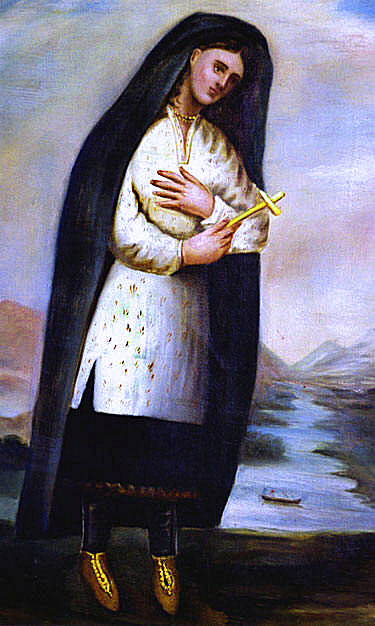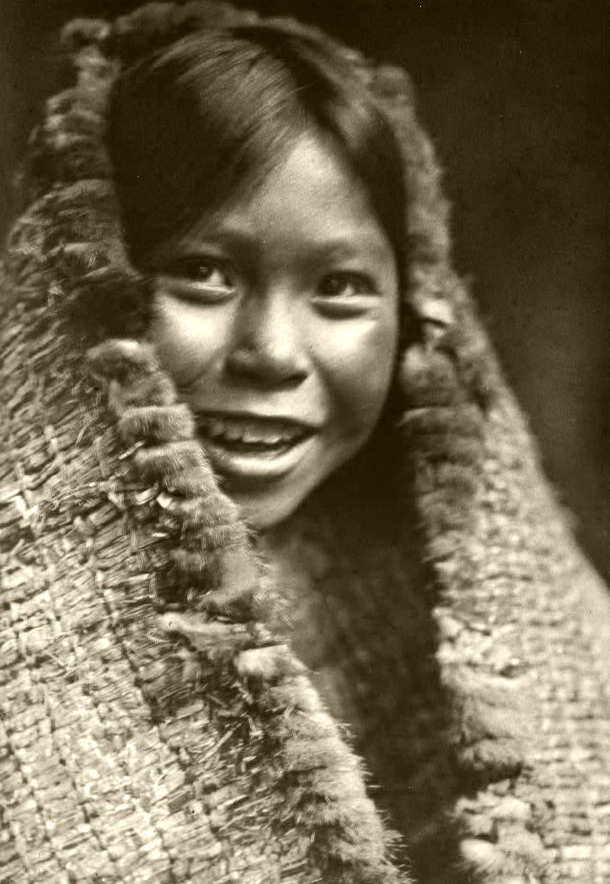Browse "Communities & Sociology"
-
Article
Clarence Dexter Wiseman
Clarence Dexter Wiseman, general of the SALVATION ARMY (b at Moreton's Harbour, Nfld 19 June 1907; d at Toronto 4 May 1985). Wiseman was commissioned as an officer in the Salvation Army in 1927. During WWII he became the senior SA representative with the Canadian Armed Forces Overseas.
"https://development.thecanadianencyclopedia.ca/images/tce_placeholder.jpg?v=e9dca980c9bdb3aa11e832e7ea94f5d9" // resources/views/front/categories/view.blade.php
https://development.thecanadianencyclopedia.ca/images/tce_placeholder.jpg?v=e9dca980c9bdb3aa11e832e7ea94f5d9
-
Article
Claude Chauchetière
Claude Chauchetière, Jesuit missionary, painter, biographer, teacher (born on 6 September 1645 in St-Porchaire-de-Poitiers, France; died 17 April 1709 in Quebec City). Chauchetière was a missionary among the Haudenosaunee in what is now Kahnawà:ke, Quebec. He painted a portrait of Kateri Tekakwitha and is considered one of the pioneer painters of New France. Chauchetière later taught mathematics in Montreal.
"https://d2ttikhf7xbzbs.cloudfront.net/media/media/edd81f0b-a2fd-4103-bc0f-b5f75d16c8d3.jpg" // resources/views/front/categories/view.blade.php
https://d2ttikhf7xbzbs.cloudfront.net/media/media/edd81f0b-a2fd-4103-bc0f-b5f75d16c8d3.jpg
-
Article
Claude de Ramezay
Claude de Ramezay, (born 15 June 1659 in La Gesse, France; died 31 July 1724 in Quebec City). Claude de Ramezay came to New France as an officer in the troupes de la marine. He served as governor of Trois-Rivières (1690–99), commander of Canadian troops (1699–1704), governor of Montreal (1704–24), and as acting governor general of New France (1714–16). Throughout his time in New France, he pursued fur trade and lumber interests. He is also remembered for his home, Château Ramezay. Built in 1705, it is now a museum and one of Montreal’s landmark historical buildings.
"https://d2ttikhf7xbzbs.cloudfront.net/media/new_article_images/ClaudedeRamezay/Claude_de_Ramezay.jpg" // resources/views/front/categories/view.blade.php
https://d2ttikhf7xbzbs.cloudfront.net/media/new_article_images/ClaudedeRamezay/Claude_de_Ramezay.jpg
-
Article
Claudette Bradshaw
Claudette Bradshaw, community activist, politician (born 8 April 1949 in Moncton, NB). Claudette Bradshaw’s early career was spent in nonprofit social work. She founded Moncton Headstart, an early family intervention centre, and advocated for at-risk youth. She was Member of Parliament for Moncton–Riverview–Dieppe from 1997 to 2006 and served in several ministerial roles in the Liberal governments of Jean Chrétien and Paul Martin, including Minister of Labour and Minister of State (Human Resources Development). Since then, she has become a major advocate for mental health, literacy and affordable housing.
"https://d2ttikhf7xbzbs.cloudfront.net/media/new_article_images/Claudette Bradshaw.jfif" // resources/views/front/categories/view.blade.php
https://d2ttikhf7xbzbs.cloudfront.net/media/new_article_images/Claudette Bradshaw.jfif -
Article
Tla-o-qui-aht (Clayoquot)
The Tla-o-qui-aht First Nation (meaning the “people from Clayoqua” or the people from “Tla-o-qui”) are a member of the Nuu-chah-nulth Tribal Council. Tla-o-qui-aht territory is located on the west coast of Vancouver Island, British Columbia. As of September 2018, the nation has a registered population of 1,147 registered members.
"https://d2ttikhf7xbzbs.cloudfront.net/media/media/4e0c3130-e80d-4e28-991d-0e077b5deb77.jpg" // resources/views/front/categories/view.blade.php
https://d2ttikhf7xbzbs.cloudfront.net/media/media/4e0c3130-e80d-4e28-991d-0e077b5deb77.jpg
-
Article
Clear Grits
Clear Grits, Upper Canadian Reformers who became discontented with the conservatism of the Baldwin-LaFontaine ministry after 1849.
"https://development.thecanadianencyclopedia.ca/images/tce_placeholder.jpg?v=e9dca980c9bdb3aa11e832e7ea94f5d9" // resources/views/front/categories/view.blade.php
https://development.thecanadianencyclopedia.ca/images/tce_placeholder.jpg?v=e9dca980c9bdb3aa11e832e7ea94f5d9
-
Article
Clémence DesRochers
Clémence DesRochers, actress, humorist, singer and author (b at Sherbrooke, Qué 24 Nov 1934). Daughter of the poet Alfred DESROCHERS, she is the most famous female monologist of her generation in Québec.
"https://development.thecanadianencyclopedia.ca/images/tce_placeholder.jpg?v=e9dca980c9bdb3aa11e832e7ea94f5d9" // resources/views/front/categories/view.blade.php
https://development.thecanadianencyclopedia.ca/images/tce_placeholder.jpg?v=e9dca980c9bdb3aa11e832e7ea94f5d9
-
Article
Clémence DesRochers
Clémence DesRochers. Monologuist, comedian, singer-songwriter, actress, broadcaster, artist, b Sherbrooke, Que, 23 Nov 1933; honorary doctorate (Sherbrooke) 1994.
"https://development.thecanadianencyclopedia.ca/images/tce_placeholder.jpg?v=e9dca980c9bdb3aa11e832e7ea94f5d9" // resources/views/front/categories/view.blade.php
https://development.thecanadianencyclopedia.ca/images/tce_placeholder.jpg?v=e9dca980c9bdb3aa11e832e7ea94f5d9
-
Article
Clement Ligoure
Clement Courtenay Ligoure, physician (born 13 October 1887 in Trinidad; died 23 May 1922 Port of Spain, Trinidad). Dr. Ligoure was Halifax’s first Black doctor and an unsung hero of the Halifax Explosion, as he treated hundreds of patients free of charge in his home medical office. Dr. Ligoure was also instrumental in the formation of the No. 2 Construction Battalion, Canada’s first and only all-Black battalion (see Black Canadians; Caribbean Canadians).
"https://d2ttikhf7xbzbs.cloudfront.net/clementligoure/clementcourtenayligoure.jpg" // resources/views/front/categories/view.blade.php
https://d2ttikhf7xbzbs.cloudfront.net/clementligoure/clementcourtenayligoure.jpg
-
Article
Clerics of Saint-Viateur
A religious congregation founded in 1831 in Vourles (near Lyons), France, by Father Louis-Marie Querbes to educate boys and to help in the general parish ministry.
"https://development.thecanadianencyclopedia.ca/images/tce_placeholder.jpg?v=e9dca980c9bdb3aa11e832e7ea94f5d9" // resources/views/front/categories/view.blade.php
https://development.thecanadianencyclopedia.ca/images/tce_placeholder.jpg?v=e9dca980c9bdb3aa11e832e7ea94f5d9
-
Article
Clovis (Llano)
Clovis, also known as Llano, culture was an early Indigenous culture that was widely distributed throughout much of North America. These big-game hunters sought mammoths, mastodons, camels and horses that were native to North America at the time. Following the retreat of the Wisconsin glaciers, these animals became extinct, hastening the end of this stage of the history of early Indigenous peoples in North America.
"https://d2ttikhf7xbzbs.cloudfront.net/media/media/f28e80bc-14da-4c69-b71c-6e16f91ed72d.jpg" // resources/views/front/categories/view.blade.php
https://d2ttikhf7xbzbs.cloudfront.net/media/media/f28e80bc-14da-4c69-b71c-6e16f91ed72d.jpg
-
Article
Coast Salish
Coast Salish peoples have historically occupied territories along the Northwest Pacific Coast in Canada and the United States. Though each nation is different, Coast Salish peoples generally have strong kinship ties and engage in political, treaty and environmental partnerships.
"https://d2ttikhf7xbzbs.cloudfront.net/media/media/b2896e4c-6595-4766-806c-936eb1f7ba34.jpg" // resources/views/front/categories/view.blade.php
https://d2ttikhf7xbzbs.cloudfront.net/media/media/b2896e4c-6595-4766-806c-936eb1f7ba34.jpg
-
Article
Cœur de pirate
Béatrice Martin (a.k.a. Cœur de pirate), singer, songwriter, pianist, writer (born 22 September 1989, in Montreal, QC). A star in both Quebec and France, chanson artist Cœur de pirate (which translates as pirate heart) has sold more than 1 million albums and won eight Félix Awards: Debut Artist of the Year (2009), Most Celebrated Quebec Artist Outside of Quebec (2010, 2012), Female Singer of the Year (2012, 2019), Pop Album of the Year (2012, 2019) and Anglophone Album of the Year (2016). She was also named Best Francophone Artist/Group or Duo of the Year at the 2012 Canadian Independent Music Awards and won the 2022 Juno Award for Francophone Album of the Year.
"https://d2ttikhf7xbzbs.cloudfront.net/1024px-Coeur_de_pirate.jpg" // resources/views/front/categories/view.blade.php
https://d2ttikhf7xbzbs.cloudfront.net/1024px-Coeur_de_pirate.jpg
-
Article
Colored Hockey League of the Maritimes
The Colored Hockey League of the Maritimes (CHL) was an all-Black men’s hockey league. Organized by Black Baptists and Black intellectuals, it was founded in Halifax, Nova Scotia, in 1895. It was defunct during and after the First World War, reformed in 1921 and then fell apart during the Depression in the 1930s. Play was known to be fast, physical and innovative. The league was designed to attract young Black men to Sunday worship with the promise of a hockey game between rival churches after the services. Later, with the influence of the Black Nationalism Movement and rising interest in the sport of hockey, the league came to be seen as a potential driving force for the equality of Black Canadians. Canada Post issued a commemorative stamp in honour of the league in 2020. In 2024, the league was declared an event of national historic significance by Parks Canada.
"https://d2ttikhf7xbzbs.cloudfront.net/Coloured Hockey League.jpg" // resources/views/front/categories/view.blade.php
https://d2ttikhf7xbzbs.cloudfront.net/Coloured Hockey League.jpg
-
Article
Columbia River Treaty
The Columbia River Treaty was signed by Canada and the US on 17 Jan 1961 after 15 years of preliminary investigation by the International Joint Commission, and one year (1960) of direct international negotiation. It dealt with the co-operative development of the Columbia River.
"https://development.thecanadianencyclopedia.ca/images/tce_placeholder.jpg?v=e9dca980c9bdb3aa11e832e7ea94f5d9" // resources/views/front/categories/view.blade.php
https://development.thecanadianencyclopedia.ca/images/tce_placeholder.jpg?v=e9dca980c9bdb3aa11e832e7ea94f5d9

